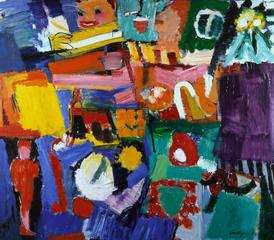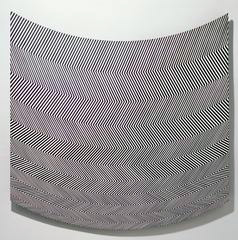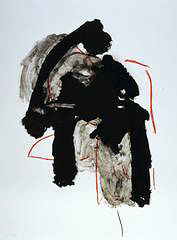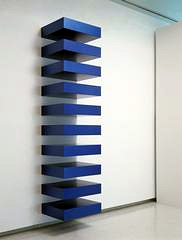 |
 |
 |
 |
 |
Jan Myers creates movement in her quilts through repetition and alternation of colors. Only after looking closely do
we see that, like the keys on a piano, every square in the quilt moves up a note in value. Laid over the diagonal "cylinders"
of graduated color is a beige grid that appears lighter or darker, depending on the colors behind it. Our eye races across this quilt,
up and down and over the rolling cylinders. |
 |
Jan Myers
Depth of Field
1984
Cotton; pieced and quilted
The Minneapolis Institute of Arts
Gift of the Minneapolis Foundation

|
|
 |
 |
 |
 |
 |
|
 |
 |
 |
 |
 |
In this painting there is no center of interest or resting place. Instead, the large yellow swatch on the left is
counterbalanced by an even larger patch of its complementary color, purple, on the right. Different blues balance the oranges. The red
soldier and apples are balanced by the greens. The pull of complementary color causes the viewer's attention to jump around the canvas,
creating movement. |
 |
Grace Hartigan
Billboard
1957
Oil on canvas
The Minneapolis Institute of Arts
The Julia B. Bigelow Fund

|
|
 |
 |
 |
 |
 |
|
 |
 |
 |
 |
 |
A pulsing rhythm is set in motion by alternating the direction of bands of diagonal lines in this painting. Op Art
paintings, called Op because they often contain optical effects, often present dizzying rhythms like the pattern seen here. |
 |
Bridget Riley
Suspension
1964
Emulsion on wood
Walker Art Center
Gift of Mr. and Mrs. Julius E. Davis

|
|
 |
 |
 |
 |
 |
|
 |
 |
 |
 |
 |
A back-and-forth rhythm is implied by the calligraphic "writing" technique used to make this print. Thick and thin
lines show directional movement as well. |
 |
Robert Motherwell
Calligraphy I
1989
Lithograph on paper
Walker Art Center
Walker Art Center, Tyler Graphics Archive

|
|
 |
 |
 |
 |
 |
|
 |
 |
 |
 |
 |
By comparison to the activity of the previous print, this minimal work seems to stand still. Yet it has both rhythm and
movement. Alternating blue squares at regular intervals set up a rhythm between shape and negative space, and suggest movement from one
square to the next. |
 |
Donald Judd
untitled
1969/1982
Anodized aluminum
Walker Art Center
Gift of Mr. and Mrs. Edmond R. Ruben

|
|
 |
 |
 |
 |
 |









